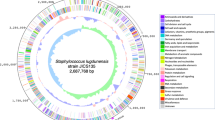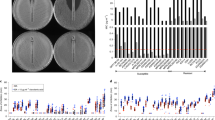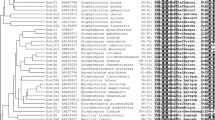Abstract
We describe for the first time the emergence of an mecA-negative Staphylococcus lugdunensis strain with a modified PBP1A/1B that expresses resistance to all β-lactams. A duplication of the tetrapeptide S569AYG, which is part of the transpeptidase domain of PBP1A/1B and closely located to the K583TG catalytic motif, was associated with this unusual phenotype.

Similar content being viewed by others
References
Frank KL, del Pozo JL, Patel R (2008) From clinical microbiology to infection pathogenesis: how daring to be different works for Staphylococcus lugdunensis. Clin Microbiol Rev 21:111–133
Clinical and Laboratory Standards Institute (CLSI) (2009) Performance standards for antimicrobial susceptibility testing; nineteenth informational supplement, 10th edn. Approved standard M100-S19. CLSI, Wayne, PA
Wood CA, Wisniewski RM (1994) Beta-lactams versus glycopeptides in treatment of subcutaneous abscesses infected with Staphylococcus aureus. Antimicrob Agents Chemother 38:1023–1026
Petinaki E, Miriagou V, Tzouvelekis LS, Hatzi F, Legakis NJ, Maniatis AN (2002) Evaluation of an anti-PBP 2a slide latex agglutination test in coagulase-negative staphylococci isolated in Greek hospitals. Diagn Microbiol Infect Dis 42(4):279–282
Chatzigeorgiou KS, Ikonomopoulou C, Kalogeropoulou S, Siafakas N, Giannopoulos G, Antoniadou A et al (2010) Two successfully treated cases of Staphylococcus lugdunensis endocarditis. Diagn Microbiol Infect Dis 68:445–448
Eswar N, Eramian D, Webb B, Shen MY, Sali A (2008) Protein structure modeling with MODELLER. Methods Mol Biol 426:145–159
Lovering AL, De Castro L, Strynadka NC (2008) Identification of dynamic structural motifs involved in peptidoglycan glycosyltransfer. J Mol Biol 383:167–177
Kotsakis SD, Miriagou V, Tzelepi E, Tzouvelekis LS (2010) Comparative biochemical and computational study of the role of naturally occurring mutations at Ambler positions 104 and 170 in GES β-lactamases. Antimicrob Agents Chemother 54:4864–4871
Shen MY, Sali A (2006) Statistical potential for assessment and prediction of protein structures. Protein Sci 15:2507–2524
Laskowski RA, MacArthur MW, Moss DS, Thornton JM (1993) PROCHECK: a program to check the stereochemical quality of protein structures. J Appl Cryst 26:283–291
van der Spoel D, Lindahl E, Hess B, Groenhof G, Mark AE, Berendsen HJC (2005) GROMACS: fast, flexible, and free. J Comput Chem 26:1701–1718
Sorin EJ, Pande VS (2005) Exploring the helix–coil transition via all-atom equilibrium ensemble simulations. Biophys J 88:2472–2493
Hackbarth CJ, Kocagoz T, Kocagoz S, Chambers HF (1995) Point mutations in Staphylococcus aureus PBP 2 gene affect penicillin-binding kinetics and are associated with resistance. Antimicrob Agents Chemother 39:103–106
Petinaki E, Dimitracopoulos G, Spiliopoulou I (2001) Decreased affinity of PBP3 to methicillin in a clinical isolate of Staphylococcus epidermidis with borderline resistance to methicillin and free of the mecA gene. Microb Drug Resist 7(3):297–300
Petinaki E, Arvaniti A, Bartzavali C, Dimitracopoulos G, Spiliopoulou I (2002) Presence of mec genes and overproduction of beta-lactamase in the expression of low-level methicillin resistance among staphylococci. Chemotherapy 48(4):174–181
Fuda C, Suvorov M, Vakulenko SB, Mobashery S (2004) The basis for resistance to beta-lactam antibiotics by penicillin-binding protein 2a of methicillin-resistant Staphylococcus aureus. J Biol Chem 279:40802–40806
Acknowledgments
This work was partially supported by the Medical School of the University of Thessalia (grant no. 3917).
Author information
Authors and Affiliations
Corresponding author
Rights and permissions
About this article
Cite this article
Kotsakis, S.D., Tzouvelekis, L.S., Zerva, L. et al. Staphylococcus lugdunensis strain with a modified PBP1A/1B expressing resistance to β-lactams. Eur J Clin Microbiol Infect Dis 31, 169–172 (2012). https://doi.org/10.1007/s10096-011-1289-8
Received:
Accepted:
Published:
Issue Date:
DOI: https://doi.org/10.1007/s10096-011-1289-8




